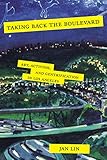Taking Back the Boulevard : Art, Activism, and Gentrification in Los Angeles / Jan Lin.
Material type: TextPublisher: New York, NY : New York University Press, [2019]Copyright date: ©2019Description: 1 online resourceContent type:
TextPublisher: New York, NY : New York University Press, [2019]Copyright date: ©2019Description: 1 online resourceContent type: - 9781479809806
- 9781479862429
- SOCIAL SCIENCE / Sociology / Urban
- Arroyo Arts Collective
- Arroyo Culture
- Arts and Crafts movement
- Autry National Center of the West
- Boyle Heights
- Friends of the Southwest Museum Coalition
- Highland Park Overlay Zone
- LA mayor's Great Streets
- Latin American and Asian immigrants
- Latino arts renaissance
- Latino experience
- Latino
- Los Angeles
- Lummis Day Festival
- Northeast LA Alliance
- Northeast LA art scene
- Take Back the Boulevard
- accumulation by dispossession
- affordable housing
- anti-gentrification protest
- arts entrepreneurs
- bicycle culture
- creative economy
- cultural policy
- displacement and eviction
- displacement
- ethnic transition
- eviction
- gentrification
- hipster
- historic preservation
- homelessness
- immigrants
- land-use planning
- neighborhood activism
- neighborhood revitalization
- outer suburbs
- preservation
- regional transit policy
- rehabilitating gang members
- revitalization
- right to the city
- slow growth
- smart growth
- social trauma
- stage model of gentrification
- streetcar suburbs
- taco truck
- tenants rights
- the Eagle Rock Association
- transit-oriented development
- urban policy
- vintage Americana
- white flight
- 307.1/40979494 23/eng/20230216
- online - DeGruyter
| Item type | Current library | Call number | URL | Status | Notes | Barcode | |
|---|---|---|---|---|---|---|---|
 eBook
eBook
|
Biblioteca "Angelicum" Pont. Univ. S.Tommaso d'Aquino Nuvola online | online - DeGruyter (Browse shelf(Opens below)) | Online access | Not for loan (Accesso limitato) | Accesso per gli utenti autorizzati / Access for authorized users | (dgr)9781479862429 |
restricted access online access with authorization star
http://purl.org/coar/access_right/c_16ec
The promises and conflicts faced by public figures, artists, and leaders of Northeast Los Angeles as they enliven and defend their neighborhoods Los Angeles is well known as a sprawling metropolis with endless freeways that can make the city feel isolating and separate its communities. Yet in the past decade, as Jan Lin argues in Taking Back the Boulevard, there has been a noticeable renewal of public life on several of the city's iconic boulevards, including Atlantic, Crenshaw, Lankershim, Sunset, Western, and Wilshire. These arteries connect neighborhoods across the city, traverse socioeconomic divides and ethnic enclaves, and can be understood as the true locational heart of public life in the metropolis. Focusing especially on the cultural scene of Northeast Los Angeles, Lin shows how these gentrifying communities help satisfy a white middle-class consumer demand for authentic experiences of "living on the edge" and a spirit of cultural rebellion. These neighborhoods have gone through several stages, from streetcar suburbs, to disinvested neighborhoods with the construction of freeways and white flight, to immigrant enclaves, to the home of Chicano/a artists in the 1970s. Those artists were then followed by non-Chicano/a, white artists, who were later threatened with displacement by gentrifiers attracted by the neighborhoods' culture, street life, and green amenities that earlier inhabitants had worked to create. Lin argues that gentrification is not a single transition, but a series of changes that disinvest and re-invest neighborhoods with financial and cultural capital. Drawing on community survey research, interviews with community residents and leaders, and ethnographic observation, this book argues that the revitalization in Northeast LA by arts leaders and neighborhood activists marks a departure in the political culture from the older civic engagement to more socially progressive coalition work involving preservationists, environmentalists, citizen protestors, and arts organizers. Finally, Lin explores how accelerated gentrification and mass displacement of Latino/a and working-class households in the 2010s has sparked new rounds of activism as the community grapples with new class conflicts and racial divides in the struggle to self-determine its future.
Mode of access: Internet via World Wide Web.
In English.
Description based on online resource; title from PDF title page (publisher's Web site, viewed 01. Nov 2023)


